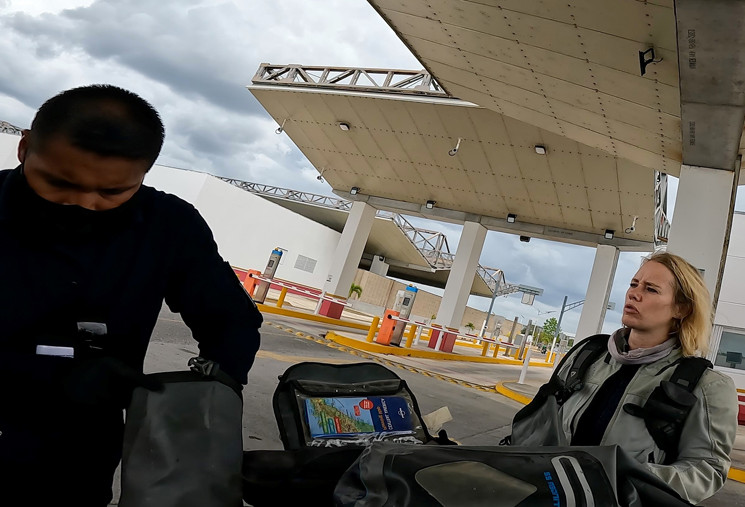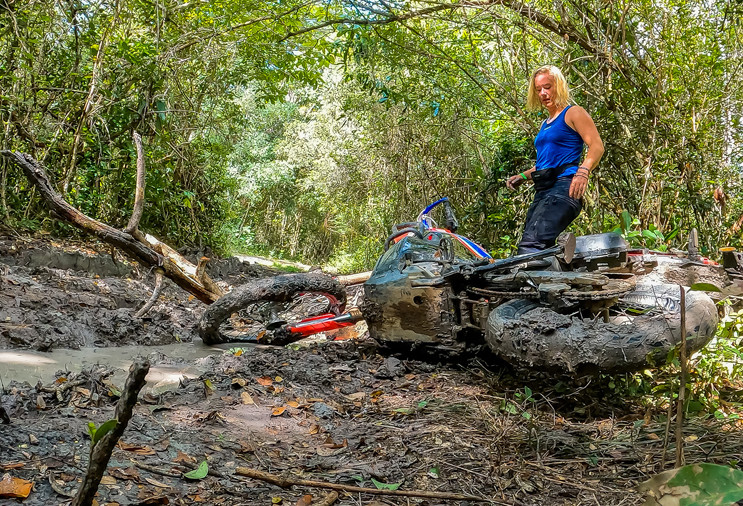
Experiencing local life is not all romance
Season 6: Project Alaska
15 March 2022I enjoy going back to countries that I already visited before. Seeing what changed over time, visiting places that I hadn’t the first time, and getting to know the local culture even better.
My current ride through Central America gets me to think back to my first time in this area, some 10 years ago. As a backpacker, I traveled with local buses through Mexico, Guatemala, El Salvador, Belize, Honduras, Nicaragua, Costa Rica, and Panama. At the time, I was following what is often referred to as 'the backpacker trail'. You visit the highlights of each country, the must-sees, and you do the must-does. Usually, you end up hopping from city to city and don’t experience much from the countryside and remote places.
Traveling on a motorcycle has changed the way I travel drastically. Now that I am not limited to the public bus routes any longer, I want to get off the beaten track even more and learn more about each country that I visit. That is why I like to visit a random little town in the mountains that receives no visitors at all. Or bring a motorcycle to a town where no other traveler has ever brought a motorcycle before.
When traveling through Central America, I got more and more interested in the indigenous people. Even though I had been in all of these countries ten years ago, only now do I fully realize how many different indigenous peoples live here. All with their own native language, their own customs, culture, and physical appearances. It fascinates me.
Meeting the Rama in Nicaragua
After meeting the Chuar/Achuar couple in Ecuador, and the Naso tribe in Panama, I started researching the indigenous people of Nicaragua. That's how I came across the Rama Indians.
At this moment, there are about 2,000 Rama living in Nicaragua. Most of them live on the island of Rama Cay, close to Bluefields lagoon. However, some 20 years ago, several Rama Indian families moved to the River Indio, and nowadays, almost 40 families live on the banks of this river. I decided I wanted to learn more about these people and try to stay with them for a few days.
The Rama indians are descendants of indigenous people that occupied the Caribbean coast of Nicaragua. During the Spanish colonization, British pirates formed an alliance with another indigenous people, the Miskitos, to gain control over the Caribbean coast and raid Spanish ships. According to Rama history, the Miskitos gifted the island of Rama Cay to them in the 18th century, in return for their help in fighting the Naso people (who I visited in Panama).
 Visiting the Naso people in Panama
Visiting the Naso people in Panama Romance versus reality
There is a romantic view of the way the Rama indians and Naso live. Their homes, their food, everything is organic and natural. They can live completely self-sufficient and off grid, if they want to. They eat river shrimp, freshly harvested rice, plantains, and organic honey from their beehives. On top of all, they are surrounded only by the sounds of the jungle.
The Naso and Rama indians may have been enemies in the past, but they now face very similar issues in regard to the disappearance of their native language, land ownership, and other indigenous rights.
The Naso people are threatened in their livelihood by hydroelectric dams that will drastically reduce the water levels of the river they live along. The Rama indians face people from other parts of Nicaragua who are claiming (illegally) Rama land. When I traveled further up the river with Santo, a Rama indian, we passed several small boats with people that were clearly not Rama, I immediately felt something was off. Whenever we would pass a boat with people who now live on their lands, I could feel the tension. There were no greetings, just intense stares, from both sides.
It was then that I learned that land was being taken from the Rama indians, trees cut down, and wild animals killed. The Rama indians are the official guardians of the Indio Maiz Nature Reserve, which includes the Rio Indio, but they are powerless to people who violently claim land in the reserve. These developments are only recent and started after 2018, the year protests erupted in Nicaragua, which led to the tragic death of hundreds of students. The Rama can only hope that the people will move away soon on their own account. From the bottom of my heart, I hope so too.
Change starts with awareness
I found it heartbreaking to see these hardships, especially because the people welcomed me so warmly and openly into their homes. No matter how many questions I fired at them, ranging from how they cook their meals and built their homes, to politics, religion, and deeper life questions - they would answer every question patiently, allowing me to learn as much about them as I liked to.
Traveling deeper into a country, going off the beaten track, meeting locals, will often show you a very different country than when you only visit the main tourist attractions. Sometimes you will see the absolute best, and sometimes the worst. Even though it can be painful to see horrible situations, I remind myself that I am in a privileged position of merely passing by. I don't have to live that reality every day, as the Naso and Rama people do.
On my way north, I intend to keep looking for unknown places and meet local people like Santo. To experience the beauty and imperfections of each country, to meet and learn from locals, and share those experiences with you. Because I think any sort of change will always start with awareness.
Ps. In this blog I use the term Rama Indians, as my guide called them that way, ‘los indios Rama’. I am aware that the term indigenous people may be more correct.
Noraly, I eagerly await each new episode.
Here’s a crazy suggestion. Get on the most direct route north and start hammering some 300 - 500 mile days. Don’t slow down until you make it to Prudhoe Bay. Then turn around and spend all of July and August exploring Alaska and Canada, all of September and October in the U.S., and re-enter Mexico in November with no rush.

Noraly, Your travels and interaction with the people along the way are an inspiration to all of us to see the good side of daily life in all the countries through which you travel. Thank you for being such a great ambassador! Stay safe.
Inspired .
I admire you so much. Tough as nails and ready to laugh at adversity. Curiouse as to wether you plan on riding I 5 interstate or Pacific Coast Hiway 101 up the West Coast as there is not many , if any, dirt roads as direct. If you go through eastern Oregon please watch for deer, they are thick there. I hit one on my 454 Ltd on Hiway 31 once. Prayers up for your safe ride to Alaska.
Hello Noraly! My wife and I are really enjoying your videos. And you have inspired me to get back out on two wheels again. Just around town. Not the jungle! hehehe If you find yourself around Prescott, Arizona someday, give us a shout. We'll buy ya lunch! :) All the best!

Great stuff Noraly, I really appreciate how you take some time to learn with every adventure. Inspiring me to get out and explore more. I sent you a message on IG with a recommendation for a place to stay if you go the coastal route and head through California. Hope it helps. Ride safe.

I love CA. The people, experiences, scenery and food were top notch. The only delta I had was in Costa Rica where I was detained for a week. They were convinced I was someone else. It wasn't fun, but it wasn't scary either-my concern was being able to leave...it was quite a story. LOL
Looking forward to riding along as you enter the states, and eventually make your way to Oregon and Washington.. BTW, the border crossing into the States is easy. You will love riding here!
Great seeing the out of the way places of Central America. When you are in the U.S. if you plan on going to or near Yellowstone National Park (which I highly recommend) try to ride the Beartooth Highway. It has been called the most beautiful drive in America.
In your last paragraph you mention "the term indigenous people may be more correct" than "Indians."
More POLITICALLY correct, maybe, but I must tell you, here in urban Canada I find that the vast majority of the indians refer to themselves as indians and most have absolutely no problem with 'non-indigenous" people referring to them as indians (as long as it is not being used as a pejorative term, of course)
I am a native-born Canadian, decended from European immigrants who migrated to the Americas in the 19th century. Although I have blue eyes and blond hair, and I get awful sunburns sometimes, I have never even visited Europe, not even once. So, I must say, it kinda bugs me a little bit when somebody calls me "european." No offence intended towards any actual Europeans. LOL.

Hi Noraly - are you planning to go through El Salvador? Thought you might be interested in seeing this: - https://edition.cnn.com/2022/03/27/world/el-salvador-state-of-emergency-homicides-intl-latam/index.html
The latest episode is fabulous, maybevthe best so far.
Keep up the good work


